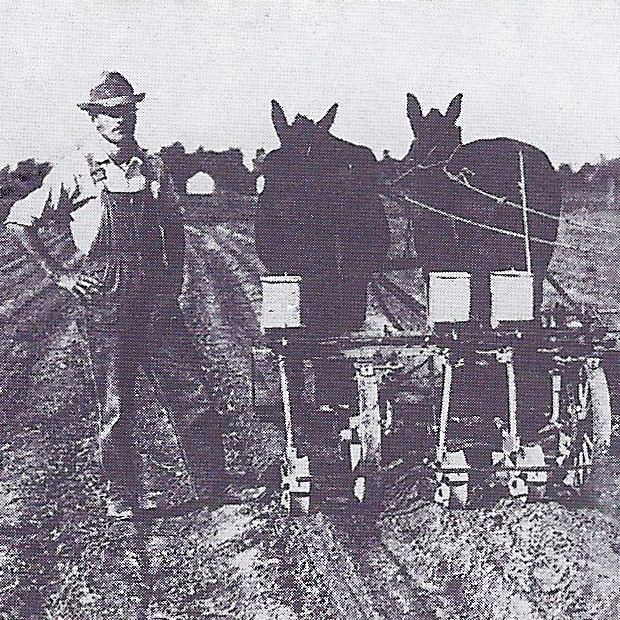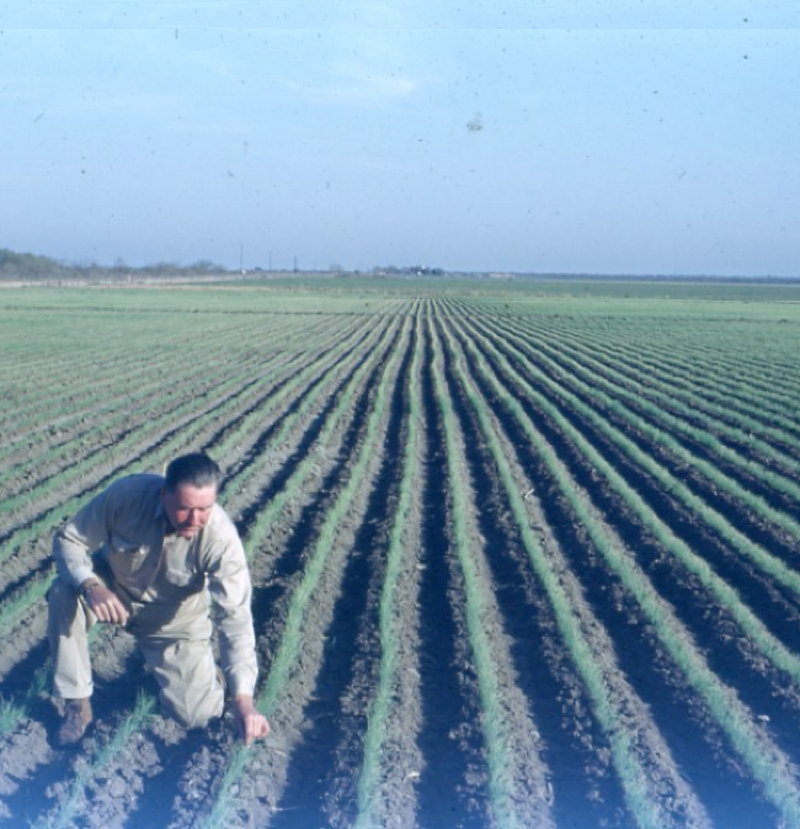-
 John, 1937
John, 1937 -
 Herman, 1945
Herman, 1945 -
 Charles and Irene Wetegrove, 1998
Charles and Irene Wetegrove, 1998
The Story Begins
The Wetegrove story begins in Germany in the late 1800s. Herman Wetegrove immigrated to the U.S. and arrived in the lower Texas valley in the early 1900s. He started growing produce in Mercedes, Texas, in 1908 and began shipping commercially 10 years later. Herman was later joined by his sons, John and Adolph. They moved to Raymonville in 1937 where the Wetegroves continue to grow and ship.
John’s son, Charles, graduated from high school and enlisted in the Marine Corps. After his discharge in 1946, he began his work in the industry. He moved to Chicago and worked with the Piowaty Gergert Company buying carlots of onions from most of the onion producing states.It was during this time that Charles became quite well-known in the industry.
Charles married Irene Groesbeeck of Laredo, Texas in 1952 and they moved back to Texas two years later, the same year Charles started the Charles Wetegrove Company. The couple had 10 children-six boys and four girls. All of the children have been involved with the company at one time or another. Today it is in the hands of Tom and Dan, who are continuing to ship under the Texocrat label their father started 50 years ago.
“I can’t tell you what drove my father, except that he’s probably like me and my brother-just pride,” says Tom. Charles was involved in the Texas Citrus and Vegetable Growers and Shippers, numerous association committees including research, labor, traffic, import/export, and he has served terms on the South Texas Onion Committee and is a past board member of the National Onion Association.
“Our name has been in the business for nearly 100 years,” Tom comments. “It’s a challenge to produce good quality.” Year in and year out, good quality is what the Wetegrove strives for. It’s a reputation their father earned with years of hard work and determination, and it’s a reputation they strive to uphold today.
Texas Onions
Today, Dan grow red, yellow and white onions. In addition, they also grow cabbage, sugarcane, cotton and grain. Their fresh onions are marketed to the U.S. and Europe. Harvest can come anytime between March 1 and May 1-quite a variable time to market.
“A lot of the problem in south Texas is you don’t know how cold it’s going to be, so you don’t know when you’re harvest is going to start,” Tom says. “Sometimes you know when it’s going to end because you get a big rain in here or something, and it pretty well ruins your quality, and it all ends very abruptly. Down here, the weather can be very moody.”
During the last 20 years, there has only been three times rain hasn’t fallen sometime during the south Texas onion harvest. Some growers combat this by getting their crop in over the least amount of days possible.
“A lot of people try to get their whole crop within 30 days, and they’ll get double the acreage,” Tom explains. “Of course with that comes other concerns, one being production is bigger, and the market goes down because of the pressure on these markets. But, you have to control the things that you can.”
As moody as south Texas weather can be, Tom believes the rain is part of what makes Texas onions so sweet. As a young boy, Tom remembers tat as the early onions became ready to harvest, his grandfather, father and himself would eat raw hamburger meat with onions, salt and pepper as a sort of tradition.
“Ten times I probably ate that and never got sick,” Tom says. “There must have been something in those Texas onions.”
Mexico Onions
Being in such close proximity to Mexico, handling produce from that country is hard to ignore. The Wetevgroves do handle produce from Mexico, but they no longer farm there.
“If it wasn’t for Mexico, the first fresh onion deal would be out of south Texas,” he says. “There are as many acres of onions being produced in Mexico as there is in south Texas.
During the 1960s, according to Tom, there were about 15,000 acres of onions being produced in Texas and about 2,000 coming to the U.S. from Mexico. Acreage has changed dramatically. Now there are 15,000 acres of whites, reds and yellows coming up from Mexico and about 10,000 out of south Texas.
Learning Curve
You’d think as fourth-generation farmers, Tom and Dan would know everything there is to know about growing Texas onions. But things aren’t the same as they were for great-grandpa Herman, grandpa John or father Charles.
“We still listen to our dad, even though we have our own ideas,” Tom says. “We respect his experience and influence.”
Growing practices, markets, you name it-it’s all changed in the last 100 years.
“We were around watching, gaining knowledge of the industry,” he says. It’s that industry the generations before him have been dedicated to. It’s that industry he, as a Wetevgrove, will be dedicated for years to come.
“I don’t care what anybody says. A farm gives you a backbone of what sometimes people need in life,” he continues. “When you’re on the farm and you stay on the farm, to me, it gives you a sense of pride, when your family members have been in this forever.”
Originally published in Onion World by Carrie Kennington

